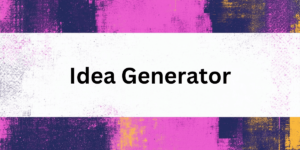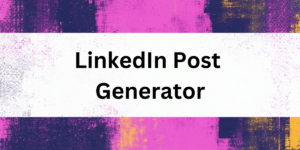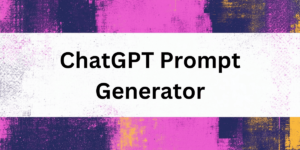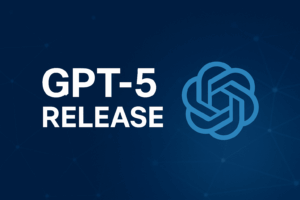In recent years, the chatter around the integration of artificial intelligence (AI) into the recruiting process has grown significantly louder. Although concrete statistics on AI’s adoption in recruitment remain elusive, one thing is clear: AI is swiftly becoming a crucial instrument for HR professionals. The recruitment process, while essential, is notoriously complex and time-consuming. It’s no surprise, then, that more companies are turning to AI to streamline their hiring practices and enhance their talent acquisition strategies. In this article, we’ll explore how AI is transforming the landscape of recruitment and what it means for the future of HR.

5 neuroflash Functions to Facilitate the Recruiting Process
Recruitment is a complex topic that requires many different skills and knowledge. While working with a recruitment agency can streamline the process for some companies, each organization often has unique requirements, procedures, and policies. This all means that the recruiting process & HR processes are difficult for those who execute it. But with artificial intelligence, you can make this process a little easier, too!
1. Convincing Job Advertisements
Every recruitment process begins with a job advertisement. The job posting is the first point of contact between the company and the applicant. It is the first impression an applicant gets from a company. Therefore, it is important that the RFP is clear and concise and conveys exactly what the company is looking for.
Creating an effective job advertisement is crucial for attracting the right candidates. neuroflash offers a set of features and templates specifically designed to aid in this process. Here’s how to generate a compelling job advertisement using neuroflash’s HR category templates:
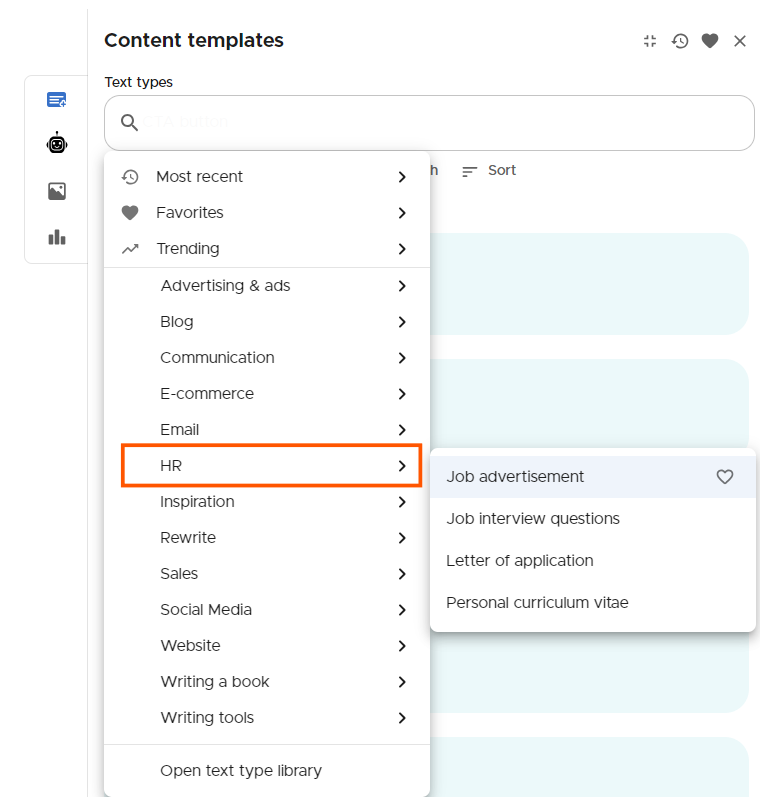
Step 1: Sign In and Navigate to HR Templates
- Sign In:
- Log into your neuroflash account. If you don’t have one, you can easily sign up on the neuroflash website.
- Navigate to Templates:
- Once logged in, go to the dashboard and locate the “Templates” section from the main menu.
- Look for the “HR” category which contains a variety of templates designed to streamline HR tasks, including job advertisements.
Step 2: Choose the Right Template
- Explore HR Templates:
- Within the HR category, browse through the available templates. You might find templates for job descriptions, employment screening, interview questions, and more.
- Select the Job Advertisement Template:
- Choose the “Job Advertisement” template, which is specifically designed to help you craft an engaging job ad.
Step 3: Input Job Details and Requirements
- Fill in Basic Information:
- Enter the job title, location, and employment type (e.g., full-time, part-time, contract).
- Describe the Company:
- Provide a brief description of your company, highlighting your mission, values, and what makes your company an attractive place to work.
- Define the Role:
- Clearly outline the main responsibilities and duties associated with the position.
- Be specific about daily tasks and long-term goals for the role.
Step 4: Specify Qualifications and Skills
- List Required Qualifications:
- Include educational background, certifications, and any specific technical skills needed for the job.
- Mention Preferred Qualifications:
- Add any additional skills or experiences that would be advantageous but are not mandatory.
- Highlight Soft Skills:
- Emphasize soft skills such as teamwork, communication, or problem-solving abilities that are important for the role.
Step 5: Utilize Advanced neuroflash Features to Enhance Your Ad
- Optimize Language:
- Use neuroflash’s AI-powered language optimization to ensure your job ad is clear, concise, and engaging.
- Incorporate Keywords:
- Leverage neuroflash’s keyword suggestion feature to incorporate relevant industry terms that will make your job ad more searchable and appealing to the right candidates.
- Sentiment Analysis:
- Use sentiment analysis to refine the tone of your job ad, ensuring it conveys the right level of enthusiasm and professionalism.
Step 6: Review and Generate the Job Advertisement
- Preview the Ad:
- Before finalizing, review the generated job advertisement for any adjustments.
- Make sure all job duties, requirements, and company information are accurate and well-presented.
- Generate Final Version:
- Once satisfied, generate the final version of your job advertisement.
- neuroflash will provide a polished and engaging job ad ready to be posted on job boards, your company website, or shared via email.
Step 7: Post and Monitor
- Distribute the Job Ad:
- Post the job ad on your preferred job boards, social media platforms, and your company’s careers page.
- Monitor Applications:
- Use neuroflash’s additional HR templates for candidate tracking and follow-up to streamline the entire recruitment process.
By following these steps, you can effectively leverage neuroflash’s HR templates to create a job advertisement that attracts top talent and meets your hiring needs efficiently.

2. Job Interview Question
The next important step in recruitment is the interview. The questions that are asked of the applicants play a major role here. Good interview questions are important because they can help you get to know the candidate better. They give the interviewer the opportunity to learn more about the candidate’s skills and experience, which is crucial once the interview call letter has been sent. Also, good questions can help get a feel for whether the candidate is a good fit for the organization and team —especially for HR recruiters aiming to streamline interviews and improve candidate selection.
To breathe fresh air into your job interview, you can use neuroflash to formulate new and inventive questions. This will liven up your interview and you won’t have to resort to outdated questions that are repeated in every interview.
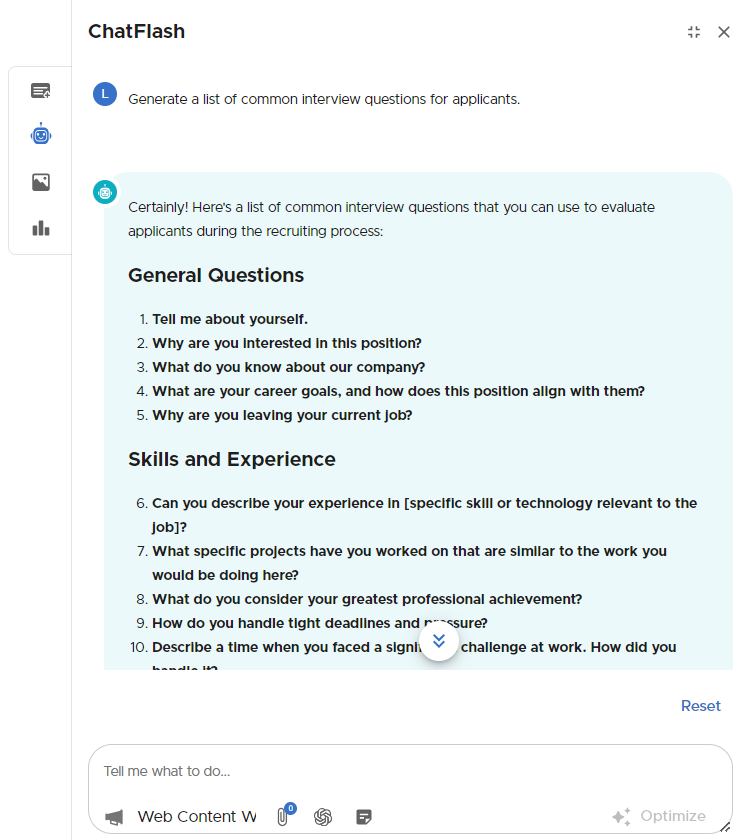
You can also make use of ChatFlash, your creative AI co-pilot that can write any kind of text from your own style. Ask it to give you a list of the most typical and relevant job interview questions. Of course, you can go further and refine the result by adding details about the job, information about the tasks, salary offered, location, etc. In this way ChatFlash will create a portfolio of interesting questions to ask, making the recruitment process much more comfortable, simple and always effective.
💡 HACK: If you already have key points for a text, or perhaps want to further formulate an existing text, you can use the neuroflash “Expand” or “Continue writing” function.
3. Well-Defined Company Vision
In addition to the recruiting process, it is also important for HR to be able to coordinate and mobilize the team. This includes formulating a concrete corporate vision that everyone strives to achieve together. The corporate vision is an essential part of a company’s strategic planning and should therefore be formulated with care. The vision gives the employees orientation and motivation, it describes where the company wants to be in the future. It forms the basis for the further strategic orientation of the company and derives the tactical measures.
With neuroflash, you can ensure that you formulate a strong vision that motivates the team, keeps them together, and steers them in the right direction. neuroflash helps you to create a corporate vision that gives a clear idea of what you want to achieve.
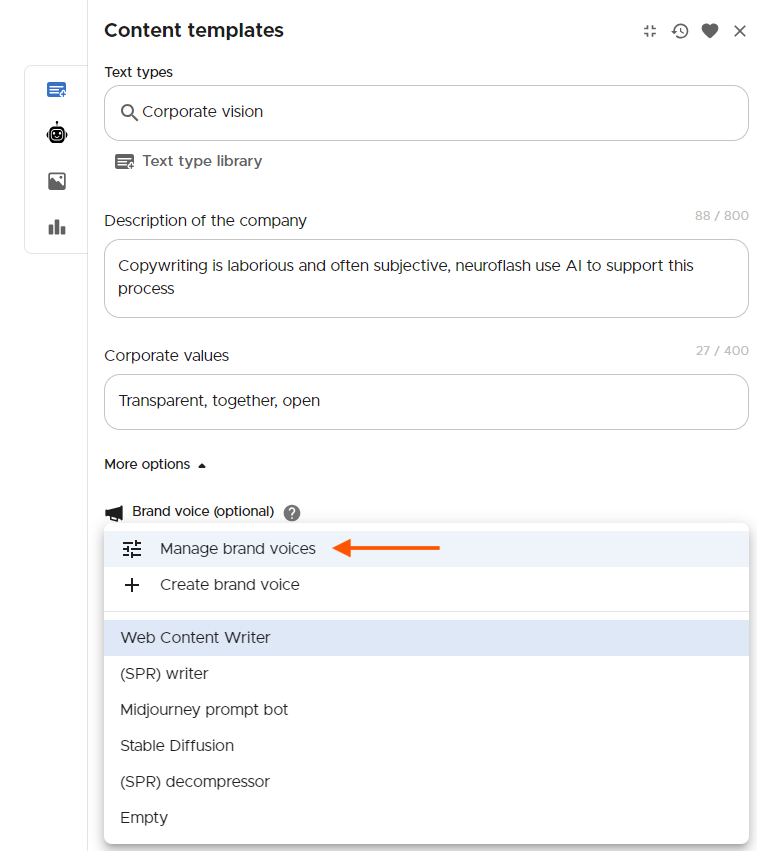
By crafting a clear and compelling corporate vision, HR can effectively coordinate and mobilize the team, ensuring everyone works towards common future goals. This vision is not just a motivational tool but also a cornerstone of the company’s strategic planning, guiding its future direction and influencing tactical measures.
The corporate vision serves as a beacon, offering orientation for employees and management alike. It helps to align individual objectives with the broader organizational goals, thereby fostering a sense of purpose and belonging among team members. A well-defined vision succinctly articulates where the company aspires to be in the years to come, providing a roadmap for decision-making and resource allocation.
With neuroflash’s Brand Hub you can work on the recruitment process aligned with your brand identity. Create your own authentic brand voice with the Brand Hub and add specific information to create content that is perfectly tailored to your or your brand.
You will be able to modify and create from scratch the brand voices from which you are going to write the HR texts. Simply choose how to do it. You can upload a document that represents your company’s knowledge, write a short text, share a sample text or copy a URL for the AI to analyze and create a brand voice from its content.
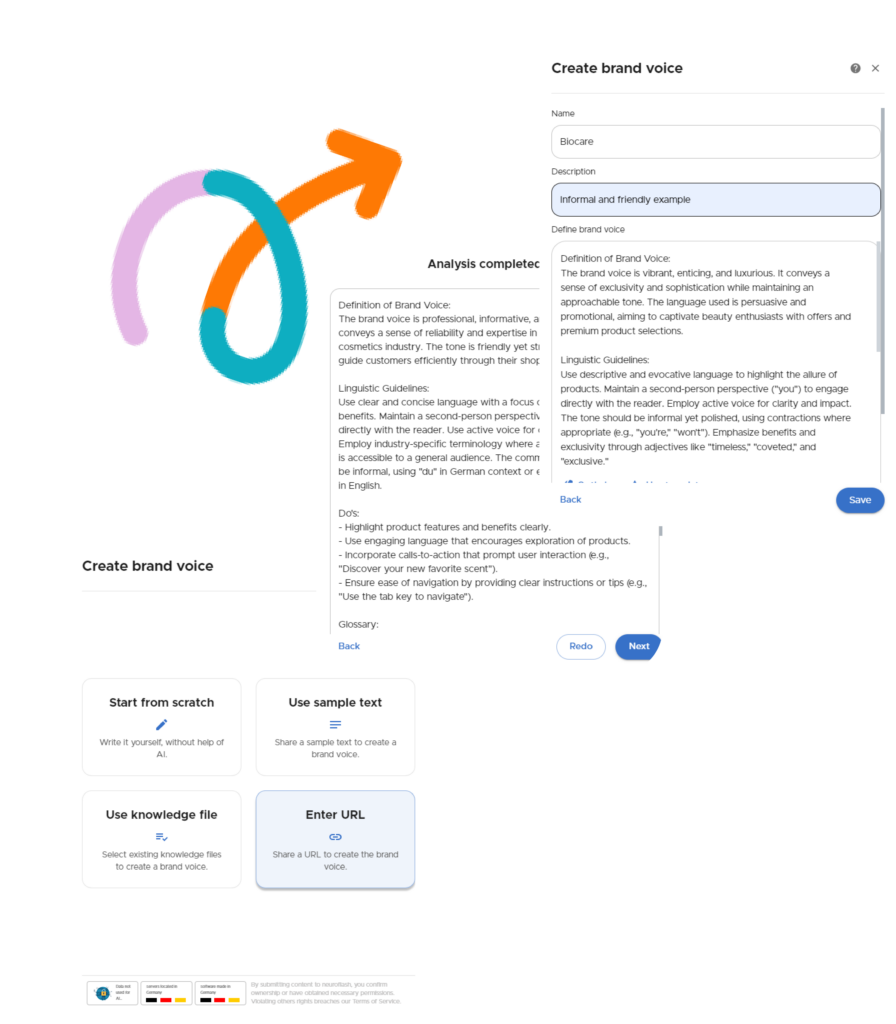
How to Create a Brand Voice for HR Texts with neuroflash
- Gather Initial Resources
- Compile Knowledge: Collect any documents, guidelines, or existing content that represents your company’s values, culture, and communication style. This could be mission statements, company policies, or previous HR communications.
- Choose Your Method for Voice Creation
- Upload a Document: Select a key document that encapsulates your company’s ethos and tone. This document will serve as the foundation for analyzing and developing your brand voice.
- Write a Short Text: If no document is available, write a brief text that embodies the desired voice. Focus on the tone, terminology, and style your company prefers.
- Share a Sample Text: Identify a sample text that aligns with your desired HR voice. This could be from outside your company if it closely matches your goals.
- Copy a URL: Provide a URL to existing online content that reflects the brand voice you wish to emulate. Ensure the content is highly relevant and accurate.
- Analyze and Create the Brand Voice
- Automated Analysis: Use AI tools to analyze the uploaded document, short text, sample text, or URL. The AI will break down the language, tone, and style used.
- Human Editing: Review the AI-generated brand voice summary. Make necessary adjustments to ensure it aligns perfectly with your company’s needs.
- Edit and Name Your Brand Voice
- Brand Voice Name: Create a distinct name for your brand voice. This could be something like “Friendly Corporate” or “Professional Warmth.”
- Short Description: Write a concise description of the brand voice. This should include key characteristics like tone, language style, and any specific elements unique to your brand.
- Example:
- Name: Professional Warmth
- Description: This brand voice is warm, approachable, and professional. It uses clear and concise language, maintains a friendly tone, and ensures all communications are inclusive and supportive.
- Save to Brand Voice Library
- Central Repository: Store this brand voice in a central library that is accessible for the HR team. This ensures consistent use across all HR communications.
- Easy Access: Ensure the library is easy to navigate so team members can quickly find and apply the brand voice.
- Application and Implementation
- Training: Conduct a training session for the HR team to familiarize them with the new brand voice. Demonstrate examples of how it should be applied across different types of communications like emails, job postings, and internal memos.
- Templates: Provide ready-to-use templates infused with the brand voice to streamline the writing process and ensure consistency.
- Review and Update Regularly
- Continuous Improvement: Schedule regular reviews of the brand voice to ensure it remains relevant and effective. Update as necessary based on feedback from the HR team and changes in company culture or values.
This guide will help you systematically develop and implement a cohesive brand voice for all HR-related communications, ensuring consistency and alignment with your company’s values.
4. Crafting a Winning Letter of Application for a Recruitment Process
Writing a compelling letter of application is a crucial step in the recruitment process. It not only showcases your qualifications but also reflects your enthusiasm for the role and the organization. A well-crafted letter can set you apart from other candidates and create a strong first impression that makes hiring managers want to learn more about you. This document serves as your personalized introduction to the potential employer, providing an opportunity to convey your professional history, skills, and passion succinctly. It’s your chance to articulate why you are the perfect fit for the job and how you can add value to the company.

With neuroflash you can formulate craft a winning letter for application jobs in a second. Once you have the job position clear, the name of the company, a short description of the job as well as a short description of your qualifications for the job, simply let the magic of AI do the hard work for you. It is that easy!
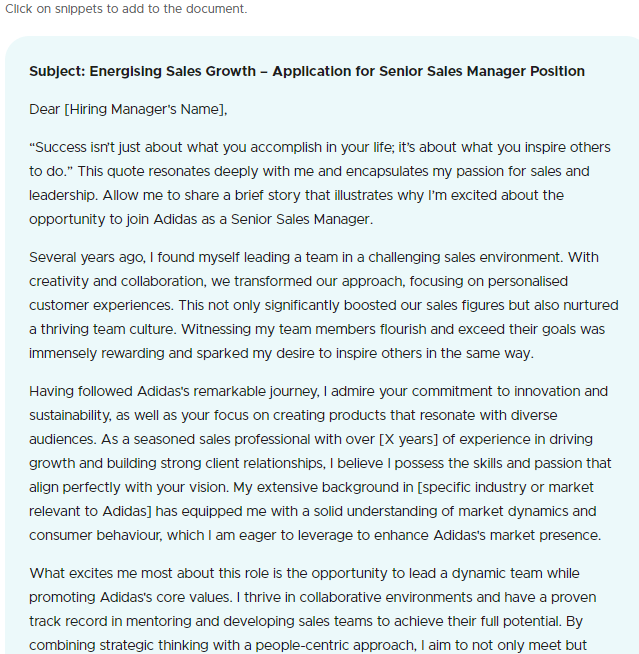
💡 TIP: You can also use neuroflash to rewrite texts. Simply select the text or phrase you want the magic feather to rewrite, click on the flash actions and choose which shade you want it to be rewritten with.
5. HR E-Mail Communications
In HR you have to communicate a lot with different people, departments and industries. Often you have to compose a large number of emails, for some of which there are no ready-made templates. This takes an extremely long time and can be especially problematic when urgent emails cannot be sent in a timely manner, causing communication to stall.
With neuroflash, writing emails becomes effortless and efficient. Gone are the days of painstakingly composing each email by hand. Instead, neuroflash allows you to generate professional and engaging emails with just one click. Whether you need to craft compelling subject lines or detailed email body text, the magic pen feature has you covered.
Imagine the convenience of quickly creating emails for any topic or occasion, from business updates and marketing campaigns to customer inquiries and personal messages. This not only saves you valuable time but also ensures that your communication remains consistent and polished. With neuroflash, you can maintain a steady flow of high-quality emails without the usual stress and effort.
What kind of HR e-mails can neuroflash write for you?
The HR team is responsible for a wide range of communications within an organization, including employee engagement surveys, policy updates, recruitment announcements, and training sessions. They ensure that messages are clear, consistent, and aligned with the company’s values, fostering a positive workplace culture.
1. Recruitment and Hiring
Job Offer Letters:
- Content: It should start with a congratulatory message and express excitement about the candidate joining the team. Include the job title, salary, benefits, start date, and any conditions of employment (e.g., background checks, reference checks). Outline next steps like signing and returning the acceptance form.
- Importance: Sets the tone for the new hire’s relationship with the company and provides essential information needed to make an informed decision.
Interview Invitations:
- Content: Begin with a polite invitation for the interview, including the position applied for. Provide details on the interview format (e.g., in-person, video call), the date and time, the location or link, who they will be meeting with, and any preparation required.
- Importance: Ensures candidates are well-prepared and reduces the likelihood of scheduling conflicts or misunderstandings.
Rejection Letters:
- Content: Thank the candidate for their interest and time. Provide a brief, polite explanation without going into too much detail. Encourage them to apply for future openings if appropriate.
- Importance: Maintains a positive relationship with candidates and preserves the company’s reputation.
Job Announcements:
- Content: Clear job title, main responsibilities, requirements, and how to apply. Optionally, include information about the company culture and benefits to attract candidates.
- Importance: Essential for reaching potential candidates and filling open positions efficiently.
2. Onboarding and Orientation
Welcome Emails:
- Content: Warmly welcome the new hire. Provide details for their first day, including start time, dress code, where to go, and who to ask for upon arrival. Include a brief introduction to the company culture and team.
- Importance: Helps new employees feel welcome and prepared, easing first-day anxiety.
Orientation Schedules:
- Content: Detailed schedule including dates, times, locations, and topics for each orientation session. List of documents they need to bring, any required pre-orientation tasks, and contacts for further questions.
- Importance: Provides structure and clarity, ensuring new hires know what to expect and can plan accordingly.
New Hire Paperwork:
- Content: List all required forms (e.g., tax forms, direct deposit forms, company policies). Provide links or instructions for completing each form and deadlines for submission.
- Importance: Ensures compliance and smooths the administrative transition for new employees.
3. Employee Relations and Engagement
Policy Updates:
- Content: Briefly explain the policy change, why it’s happening, and how it impacts employees. Include links to the full policy and contacts for questions.
- Importance: Keeps employees informed and ensures everyone is aware of and compliant with current policies.
Employee Surveys:
- Content: State the purpose of the survey, how the feedback will be used, and ensure confidentiality. Provide clear instructions and a deadline for completion.
- Importance: Gathers valuable feedback, helping management make informed decisions to improve the workplace.
Internal Newsletters:
- Content: Updates on company news, project highlights, employee achievements, upcoming events, and useful resources. Keep it engaging with a friendly tone and visuals.
- Importance: Informs and engages employees, fostering a sense of community and involvement.
4. Performance Management
Performance Review Notices:
- Content: Inform employees about upcoming reviews, what they need to prepare, and the timeline. Include instructions for completing self-assessments if applicable.
- Importance: Prepares employees and managers, ensuring an effective and organized review process.
Recognition and Rewards:
- Content: Congratulate the employee, mention specific achievements, and outline any rewards or recognition they will receive. Consider including motivational employee gifts as part of the recognition to make it more personal and memorable.
- Importance: Boosts morale and motivation, reinforcing positive behaviors and performance.
5. Compliance and Legal
Mandatory Training:
- Content: Explain the importance of the training, how it complies with regulations, and provide details on how to access and complete it.
- Importance: Ensures compliance with legal and company standards, protecting the organization and its employees.
Compliance Reminders:
- Content: Highlight the compliance requirement, deadlines, and any actions employees need to take.
- Importance: Maintains adherence to regulatory and company standards, reducing risk.
6. Employee Benefits and Compensation
Open Enrollment Notices:
- Content: Provide dates of the enrollment period, changes to benefits, and instructions for enrolling or making changes.
- Importance: Ensures employees are informed about their benefits options and deadlines, avoiding missed opportunities.
Pay and Payroll Updates:
- Content: Inform employees about payroll schedules, any changes in their pay, and contact details for payroll queries. Be sure to include access to paystubs, so employees can review their earnings, deductions, and other payroll details easily.
- Importance: Ensures transparency and resolves issues promptly, maintaining trust and satisfaction.
7. Crisis Communication
Emergency Notifications:
- Content: Clear, urgent message about the emergency, its impact, and immediate actions employees need to take. Provide regular updates and support contacts.
- Importance: Ensures safety and keeps employees informed during crises, minimizing confusion and panic.
Health and Safety Updates:
- Content: Provide guidelines and updates on health and safety measures, especially during events like pandemics. Include resources for further information.
- Importance: Protects employee well-being, ensuring compliance with health regulations and fostering a safe work environment.
8. Administrative Communications
Meeting Announcements:
- Content: Details of the meeting including agenda, date, time, location, and preparation required. Include a calendar invite if possible.
- Importance: Ensures all relevant parties are informed and prepared, promoting productive and efficient meetings.
General Inquiries:
- Content: Provide clear and helpful responses to employee inquiries about various HR-related topics.
- Importance: Supports employees by providing necessary information and resolving issues promptly.
By tailoring each type of email to its specific purpose, the HR team can enhance communication within the organization, ensuring clarity, consistency, and engagement across various HR functions. This fosters a more informed, satisfied, and productive workforce.
TIP: If you want to quickly create something specific, such as a To Do list, you can also use the neuroflash “Command” feature.
Using AI in the Recruiting Process & HR - Advantages
The use of AI in the recruiting process and in human resources is still relatively new. However, AI does bring some advantages;
- Faster than a recruiter: AI can be used to screen more applicants in less time.
- Objective: AI is not influenced by the same biases or emotions as humans.
- Creative: With the help of AI, you can bring more creativity to the application process.
- More accurate matching: AI can use large data sets to more accurately predict what qualifications an applicant should bring to fit a company.
- Better communication: AI can improve the speed and efficiency of intra-company communication. This means that many processes can be optimized.
Frequently asked questions and answers
How can I make the use of AI in the recruiting process & HR effective?
The possible applications of artificial intelligence in the recruiting process & HR are almost unlimited. Recruiting processes can be greatly simplified and accelerated through the use of text generators and AI analysis tools. For example, companies can use text generators to make initial contact with potential applicants or conduct automated preliminary interviews. AI is also relevant for optimizing communication within the company.
What experience is there already with the use of AI in the recruiting process & HR?
There are already some companies that are successfully implementing the use of AI in the recruiting process and HR. Here, AI is primarily used to speed up and simplify the search for suitable candidates. Hiring processes are also optimized through the use of AI. This can ensure, for example, that only the best candidates are considered for a position. However, the use of AI in the recruiting process and HR is still relatively new and there is no long-term experience with the use of the technology. Therefore, it is still unclear what impact the use of AI will have on the labor market as a whole.
How can I optimize my texts for the recruiting process & HR with AI?
More and more companies are turning to AI to streamline their recruiting process and HR department. The most important thing is to find the right software or tool. It is also important to communicate with the AI in such a way that the AI can also understand and correctly interpret the tasks,



